Case Study: Analysis of La Trobe Solar Power Project, FIN3CSF
VerifiedAdded on 2023/01/12
|9
|2070
|91
Case Study
AI Summary
This case study examines the La Trobe University Net Zero Solar Power Installation Project, which involves installing 7,000 solar panels across 27 buildings at the Melbourne campus. The analysis focuses on the financial feasibility of the project, utilizing capital budgeting techniques such as Net Present ...
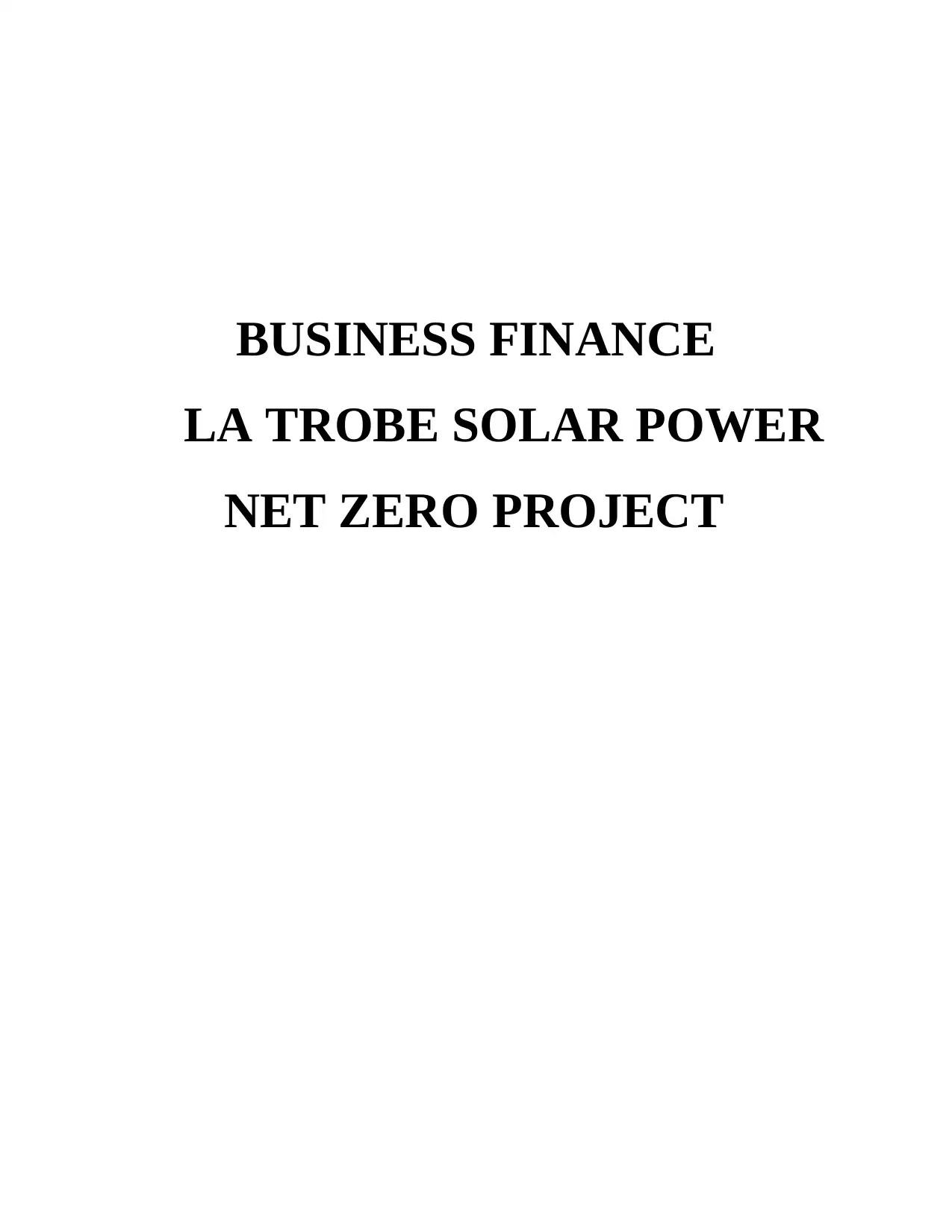
BUSINESS FINANCE
LA TROBE SOLAR POWER
NET ZERO PROJECT
LA TROBE SOLAR POWER
NET ZERO PROJECT
Paraphrase This Document
Need a fresh take? Get an instant paraphrase of this document with our AI Paraphraser
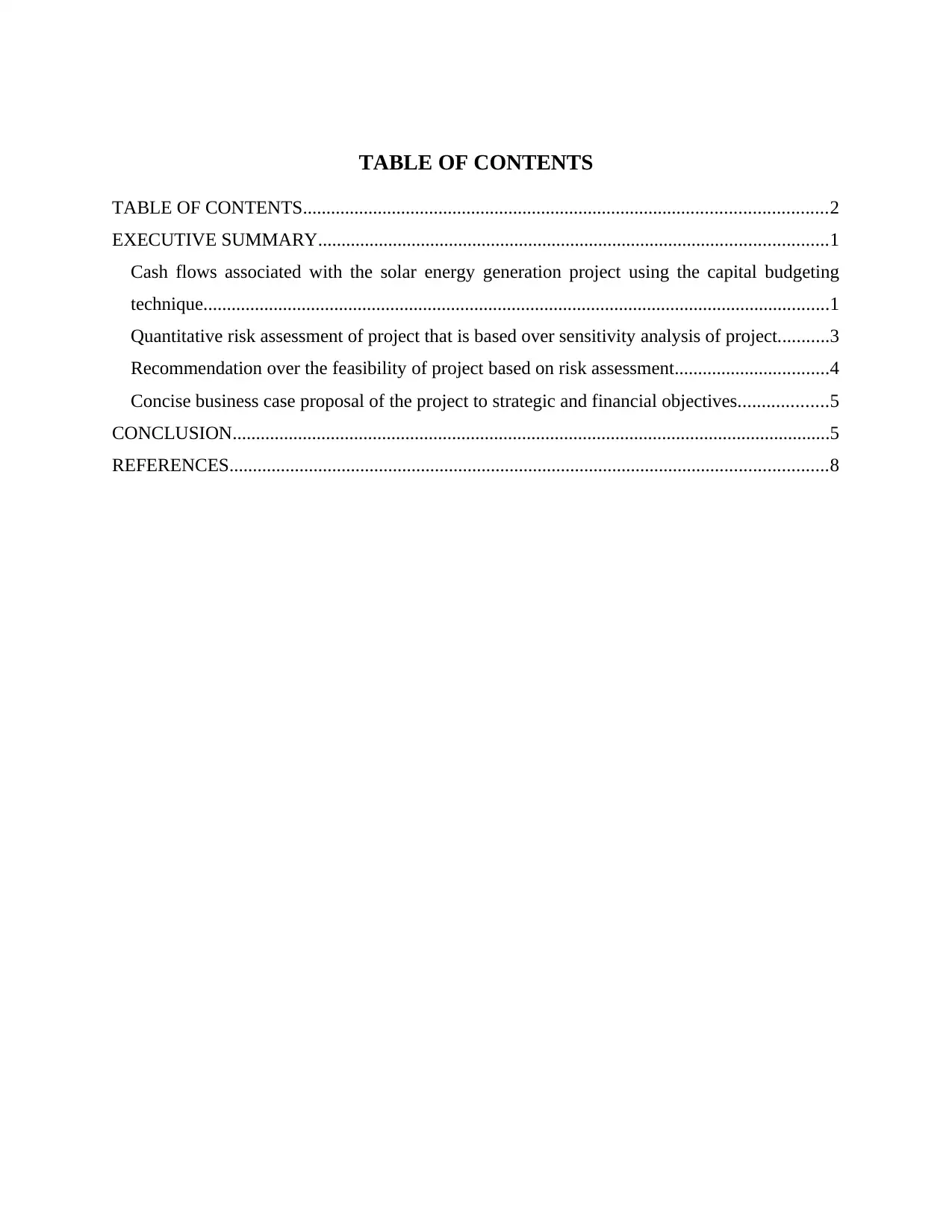
TABLE OF CONTENTS
TABLE OF CONTENTS................................................................................................................2
EXECUTIVE SUMMARY.............................................................................................................1
Cash flows associated with the solar energy generation project using the capital budgeting
technique......................................................................................................................................1
Quantitative risk assessment of project that is based over sensitivity analysis of project...........3
Recommendation over the feasibility of project based on risk assessment.................................4
Concise business case proposal of the project to strategic and financial objectives...................5
CONCLUSION................................................................................................................................5
REFERENCES................................................................................................................................8
TABLE OF CONTENTS................................................................................................................2
EXECUTIVE SUMMARY.............................................................................................................1
Cash flows associated with the solar energy generation project using the capital budgeting
technique......................................................................................................................................1
Quantitative risk assessment of project that is based over sensitivity analysis of project...........3
Recommendation over the feasibility of project based on risk assessment.................................4
Concise business case proposal of the project to strategic and financial objectives...................5
CONCLUSION................................................................................................................................5
REFERENCES................................................................................................................................8
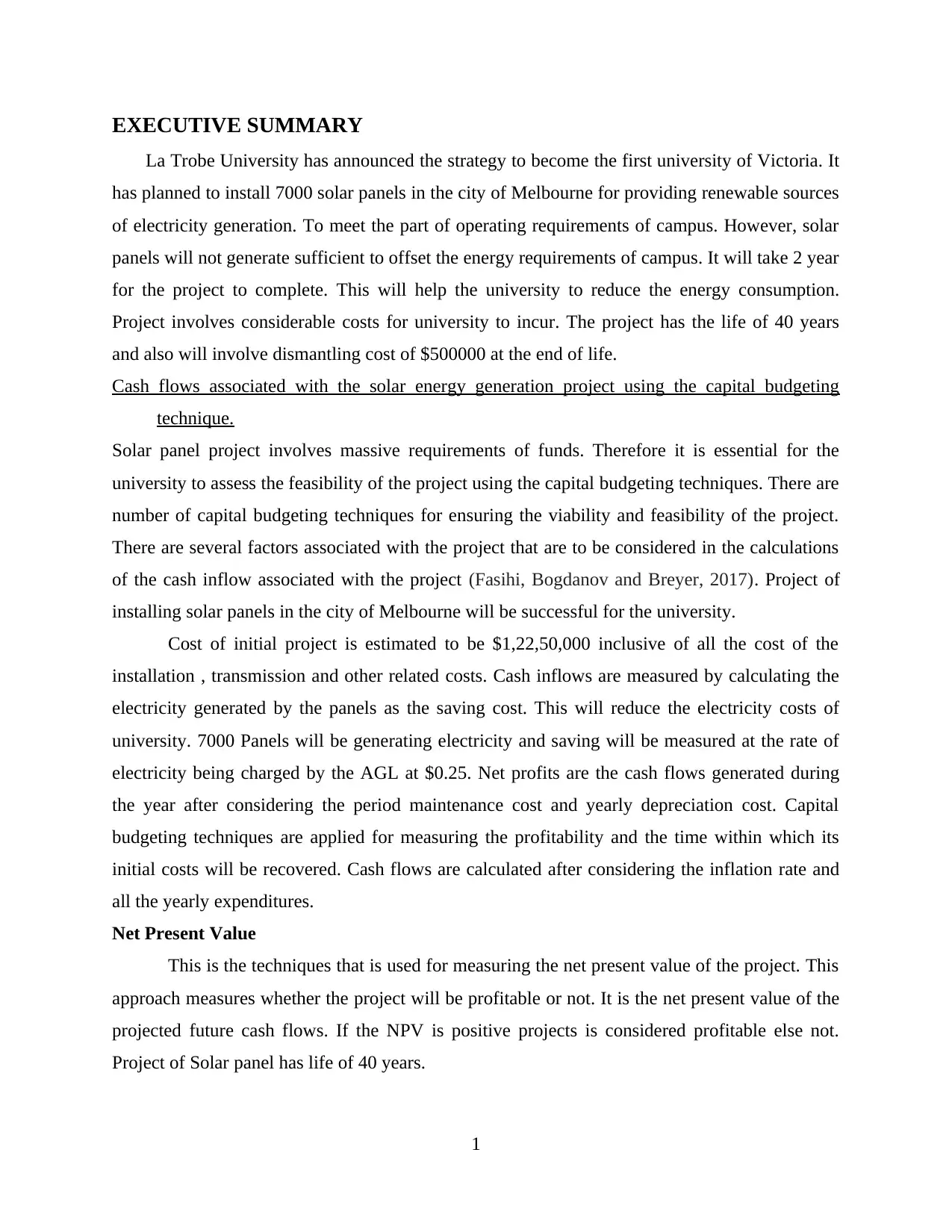
EXECUTIVE SUMMARY
La Trobe University has announced the strategy to become the first university of Victoria. It
has planned to install 7000 solar panels in the city of Melbourne for providing renewable sources
of electricity generation. To meet the part of operating requirements of campus. However, solar
panels will not generate sufficient to offset the energy requirements of campus. It will take 2 year
for the project to complete. This will help the university to reduce the energy consumption.
Project involves considerable costs for university to incur. The project has the life of 40 years
and also will involve dismantling cost of $500000 at the end of life.
Cash flows associated with the solar energy generation project using the capital budgeting
technique.
Solar panel project involves massive requirements of funds. Therefore it is essential for the
university to assess the feasibility of the project using the capital budgeting techniques. There are
number of capital budgeting techniques for ensuring the viability and feasibility of the project.
There are several factors associated with the project that are to be considered in the calculations
of the cash inflow associated with the project (Fasihi, Bogdanov and Breyer, 2017). Project of
installing solar panels in the city of Melbourne will be successful for the university.
Cost of initial project is estimated to be $1,22,50,000 inclusive of all the cost of the
installation , transmission and other related costs. Cash inflows are measured by calculating the
electricity generated by the panels as the saving cost. This will reduce the electricity costs of
university. 7000 Panels will be generating electricity and saving will be measured at the rate of
electricity being charged by the AGL at $0.25. Net profits are the cash flows generated during
the year after considering the period maintenance cost and yearly depreciation cost. Capital
budgeting techniques are applied for measuring the profitability and the time within which its
initial costs will be recovered. Cash flows are calculated after considering the inflation rate and
all the yearly expenditures.
Net Present Value
This is the techniques that is used for measuring the net present value of the project. This
approach measures whether the project will be profitable or not. It is the net present value of the
projected future cash flows. If the NPV is positive projects is considered profitable else not.
Project of Solar panel has life of 40 years.
1
La Trobe University has announced the strategy to become the first university of Victoria. It
has planned to install 7000 solar panels in the city of Melbourne for providing renewable sources
of electricity generation. To meet the part of operating requirements of campus. However, solar
panels will not generate sufficient to offset the energy requirements of campus. It will take 2 year
for the project to complete. This will help the university to reduce the energy consumption.
Project involves considerable costs for university to incur. The project has the life of 40 years
and also will involve dismantling cost of $500000 at the end of life.
Cash flows associated with the solar energy generation project using the capital budgeting
technique.
Solar panel project involves massive requirements of funds. Therefore it is essential for the
university to assess the feasibility of the project using the capital budgeting techniques. There are
number of capital budgeting techniques for ensuring the viability and feasibility of the project.
There are several factors associated with the project that are to be considered in the calculations
of the cash inflow associated with the project (Fasihi, Bogdanov and Breyer, 2017). Project of
installing solar panels in the city of Melbourne will be successful for the university.
Cost of initial project is estimated to be $1,22,50,000 inclusive of all the cost of the
installation , transmission and other related costs. Cash inflows are measured by calculating the
electricity generated by the panels as the saving cost. This will reduce the electricity costs of
university. 7000 Panels will be generating electricity and saving will be measured at the rate of
electricity being charged by the AGL at $0.25. Net profits are the cash flows generated during
the year after considering the period maintenance cost and yearly depreciation cost. Capital
budgeting techniques are applied for measuring the profitability and the time within which its
initial costs will be recovered. Cash flows are calculated after considering the inflation rate and
all the yearly expenditures.
Net Present Value
This is the techniques that is used for measuring the net present value of the project. This
approach measures whether the project will be profitable or not. It is the net present value of the
projected future cash flows. If the NPV is positive projects is considered profitable else not.
Project of Solar panel has life of 40 years.
1
⊘ This is a preview!⊘
Do you want full access?
Subscribe today to unlock all pages.

Trusted by 1+ million students worldwide
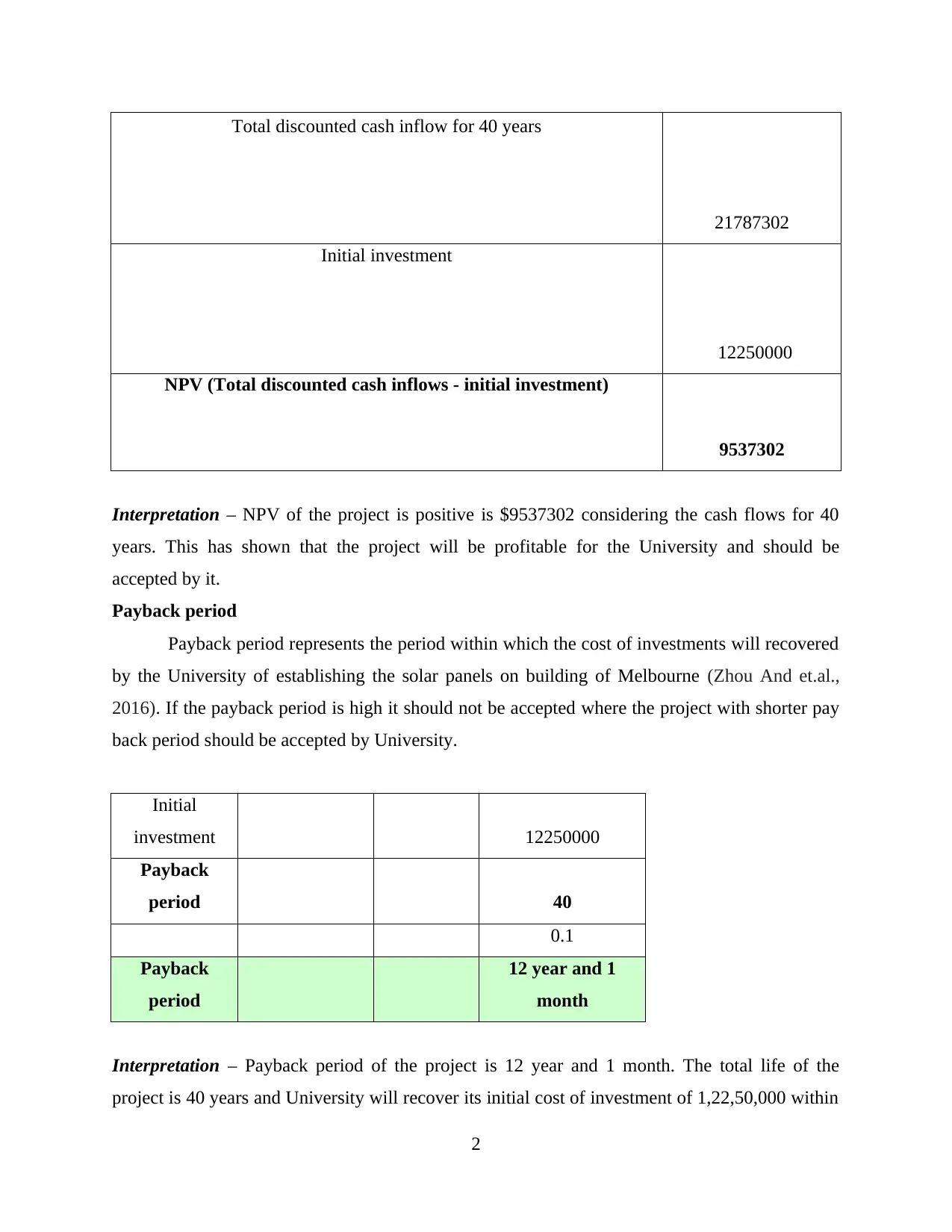
Total discounted cash inflow for 40 years
21787302
Initial investment
12250000
NPV (Total discounted cash inflows - initial investment)
9537302
Interpretation – NPV of the project is positive is $9537302 considering the cash flows for 40
years. This has shown that the project will be profitable for the University and should be
accepted by it.
Payback period
Payback period represents the period within which the cost of investments will recovered
by the University of establishing the solar panels on building of Melbourne (Zhou And et.al.,
2016). If the payback period is high it should not be accepted where the project with shorter pay
back period should be accepted by University.
Initial
investment 12250000
Payback
period 40
0.1
Payback
period
12 year and 1
month
Interpretation – Payback period of the project is 12 year and 1 month. The total life of the
project is 40 years and University will recover its initial cost of investment of 1,22,50,000 within
2
21787302
Initial investment
12250000
NPV (Total discounted cash inflows - initial investment)
9537302
Interpretation – NPV of the project is positive is $9537302 considering the cash flows for 40
years. This has shown that the project will be profitable for the University and should be
accepted by it.
Payback period
Payback period represents the period within which the cost of investments will recovered
by the University of establishing the solar panels on building of Melbourne (Zhou And et.al.,
2016). If the payback period is high it should not be accepted where the project with shorter pay
back period should be accepted by University.
Initial
investment 12250000
Payback
period 40
0.1
Payback
period
12 year and 1
month
Interpretation – Payback period of the project is 12 year and 1 month. The total life of the
project is 40 years and University will recover its initial cost of investment of 1,22,50,000 within
2
Paraphrase This Document
Need a fresh take? Get an instant paraphrase of this document with our AI Paraphraser
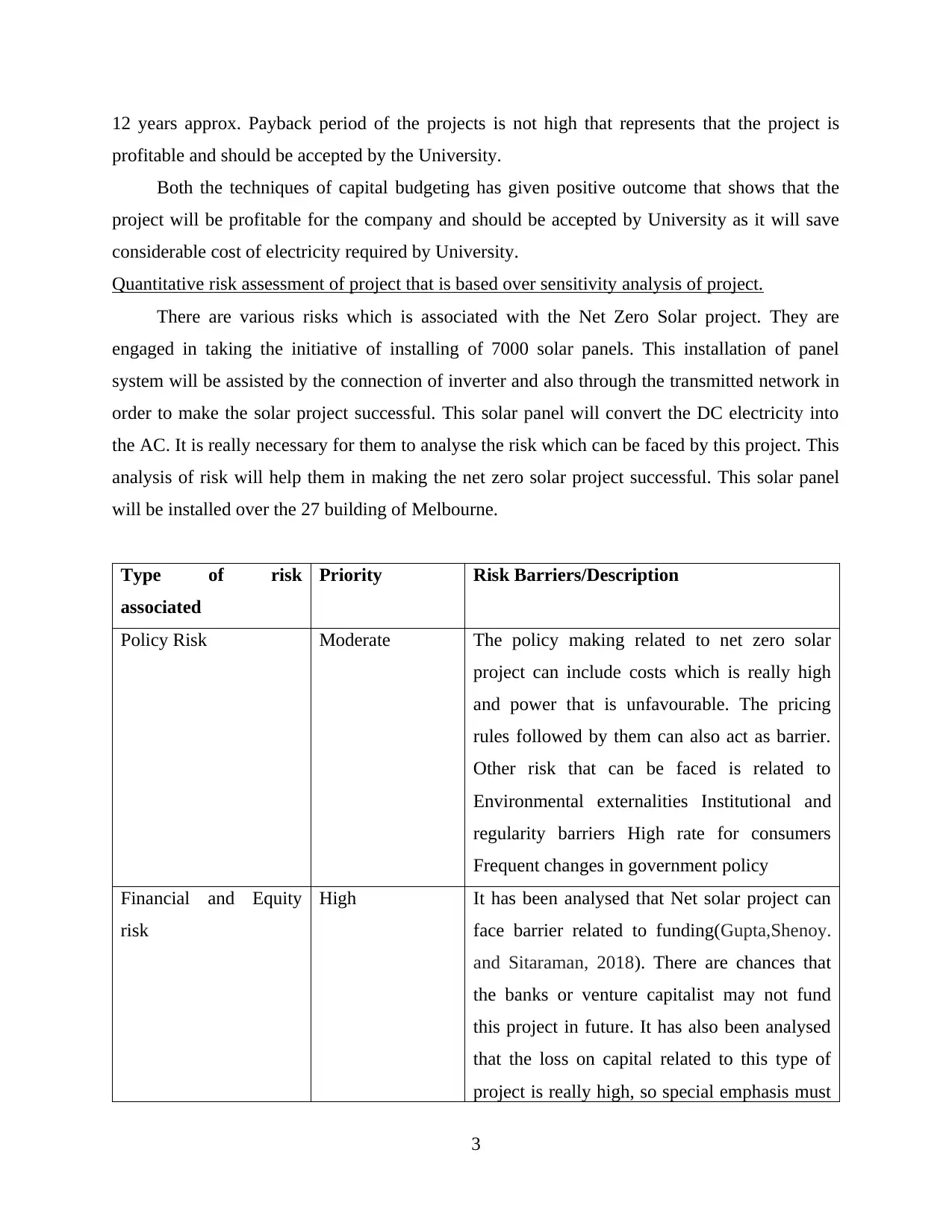
12 years approx. Payback period of the projects is not high that represents that the project is
profitable and should be accepted by the University.
Both the techniques of capital budgeting has given positive outcome that shows that the
project will be profitable for the company and should be accepted by University as it will save
considerable cost of electricity required by University.
Quantitative risk assessment of project that is based over sensitivity analysis of project.
There are various risks which is associated with the Net Zero Solar project. They are
engaged in taking the initiative of installing of 7000 solar panels. This installation of panel
system will be assisted by the connection of inverter and also through the transmitted network in
order to make the solar project successful. This solar panel will convert the DC electricity into
the AC. It is really necessary for them to analyse the risk which can be faced by this project. This
analysis of risk will help them in making the net zero solar project successful. This solar panel
will be installed over the 27 building of Melbourne.
Type of risk
associated
Priority Risk Barriers/Description
Policy Risk Moderate The policy making related to net zero solar
project can include costs which is really high
and power that is unfavourable. The pricing
rules followed by them can also act as barrier.
Other risk that can be faced is related to
Environmental externalities Institutional and
regularity barriers High rate for consumers
Frequent changes in government policy
Financial and Equity
risk
High It has been analysed that Net solar project can
face barrier related to funding(Gupta,Shenoy.
and Sitaraman, 2018). There are chances that
the banks or venture capitalist may not fund
this project in future. It has also been analysed
that the loss on capital related to this type of
project is really high, so special emphasis must
3
profitable and should be accepted by the University.
Both the techniques of capital budgeting has given positive outcome that shows that the
project will be profitable for the company and should be accepted by University as it will save
considerable cost of electricity required by University.
Quantitative risk assessment of project that is based over sensitivity analysis of project.
There are various risks which is associated with the Net Zero Solar project. They are
engaged in taking the initiative of installing of 7000 solar panels. This installation of panel
system will be assisted by the connection of inverter and also through the transmitted network in
order to make the solar project successful. This solar panel will convert the DC electricity into
the AC. It is really necessary for them to analyse the risk which can be faced by this project. This
analysis of risk will help them in making the net zero solar project successful. This solar panel
will be installed over the 27 building of Melbourne.
Type of risk
associated
Priority Risk Barriers/Description
Policy Risk Moderate The policy making related to net zero solar
project can include costs which is really high
and power that is unfavourable. The pricing
rules followed by them can also act as barrier.
Other risk that can be faced is related to
Environmental externalities Institutional and
regularity barriers High rate for consumers
Frequent changes in government policy
Financial and Equity
risk
High It has been analysed that Net solar project can
face barrier related to funding(Gupta,Shenoy.
and Sitaraman, 2018). There are chances that
the banks or venture capitalist may not fund
this project in future. It has also been analysed
that the loss on capital related to this type of
project is really high, so special emphasis must
3
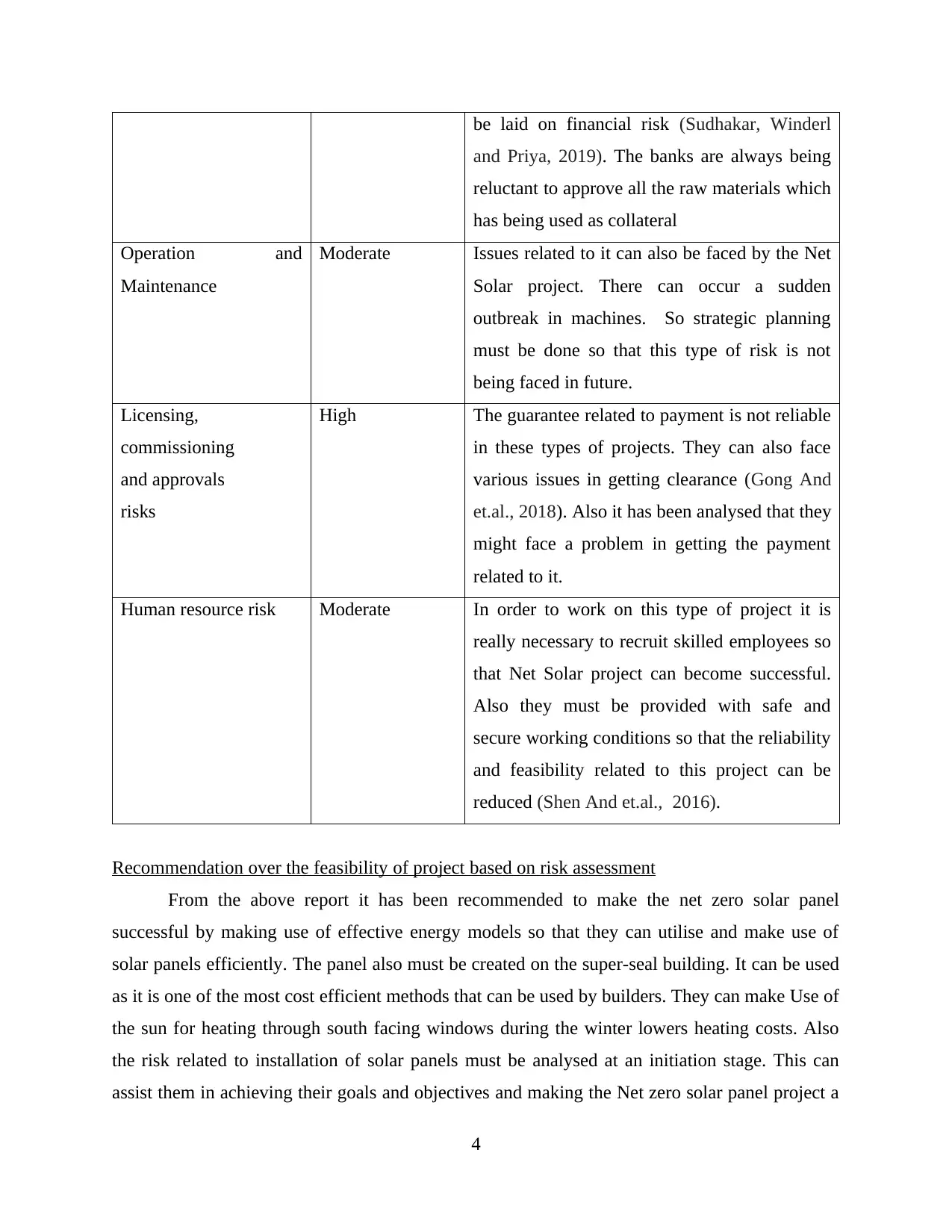
be laid on financial risk (Sudhakar, Winderl
and Priya, 2019). The banks are always being
reluctant to approve all the raw materials which
has being used as collateral
Operation and
Maintenance
Moderate Issues related to it can also be faced by the Net
Solar project. There can occur a sudden
outbreak in machines. So strategic planning
must be done so that this type of risk is not
being faced in future.
Licensing,
commissioning
and approvals
risks
High The guarantee related to payment is not reliable
in these types of projects. They can also face
various issues in getting clearance (Gong And
et.al., 2018). Also it has been analysed that they
might face a problem in getting the payment
related to it.
Human resource risk Moderate In order to work on this type of project it is
really necessary to recruit skilled employees so
that Net Solar project can become successful.
Also they must be provided with safe and
secure working conditions so that the reliability
and feasibility related to this project can be
reduced (Shen And et.al., 2016).
Recommendation over the feasibility of project based on risk assessment
From the above report it has been recommended to make the net zero solar panel
successful by making use of effective energy models so that they can utilise and make use of
solar panels efficiently. The panel also must be created on the super-seal building. It can be used
as it is one of the most cost efficient methods that can be used by builders. They can make Use of
the sun for heating through south facing windows during the winter lowers heating costs. Also
the risk related to installation of solar panels must be analysed at an initiation stage. This can
assist them in achieving their goals and objectives and making the Net zero solar panel project a
4
and Priya, 2019). The banks are always being
reluctant to approve all the raw materials which
has being used as collateral
Operation and
Maintenance
Moderate Issues related to it can also be faced by the Net
Solar project. There can occur a sudden
outbreak in machines. So strategic planning
must be done so that this type of risk is not
being faced in future.
Licensing,
commissioning
and approvals
risks
High The guarantee related to payment is not reliable
in these types of projects. They can also face
various issues in getting clearance (Gong And
et.al., 2018). Also it has been analysed that they
might face a problem in getting the payment
related to it.
Human resource risk Moderate In order to work on this type of project it is
really necessary to recruit skilled employees so
that Net Solar project can become successful.
Also they must be provided with safe and
secure working conditions so that the reliability
and feasibility related to this project can be
reduced (Shen And et.al., 2016).
Recommendation over the feasibility of project based on risk assessment
From the above report it has been recommended to make the net zero solar panel
successful by making use of effective energy models so that they can utilise and make use of
solar panels efficiently. The panel also must be created on the super-seal building. It can be used
as it is one of the most cost efficient methods that can be used by builders. They can make Use of
the sun for heating through south facing windows during the winter lowers heating costs. Also
the risk related to installation of solar panels must be analysed at an initiation stage. This can
assist them in achieving their goals and objectives and making the Net zero solar panel project a
4
⊘ This is a preview!⊘
Do you want full access?
Subscribe today to unlock all pages.

Trusted by 1+ million students worldwide
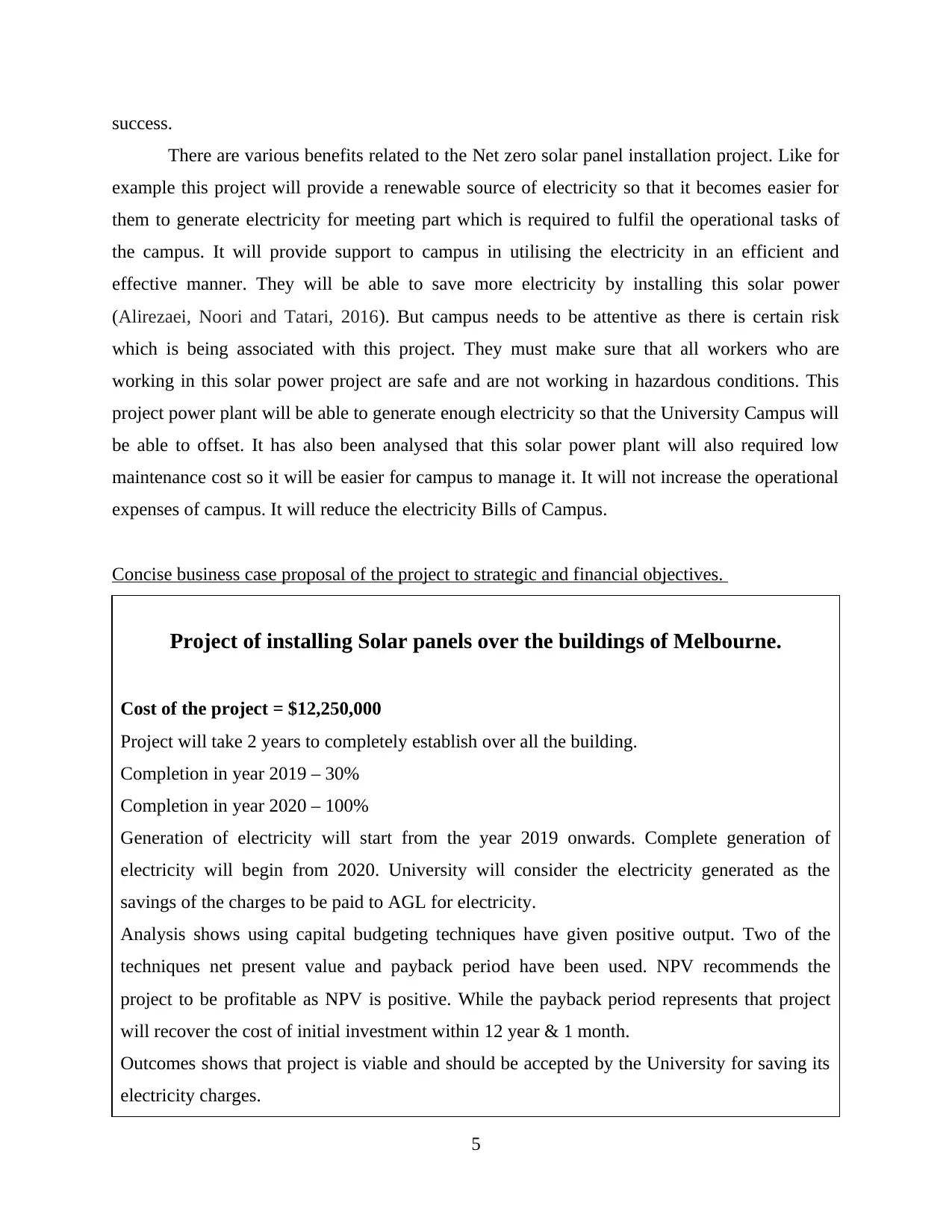
success.
There are various benefits related to the Net zero solar panel installation project. Like for
example this project will provide a renewable source of electricity so that it becomes easier for
them to generate electricity for meeting part which is required to fulfil the operational tasks of
the campus. It will provide support to campus in utilising the electricity in an efficient and
effective manner. They will be able to save more electricity by installing this solar power
(Alirezaei, Noori and Tatari, 2016). But campus needs to be attentive as there is certain risk
which is being associated with this project. They must make sure that all workers who are
working in this solar power project are safe and are not working in hazardous conditions. This
project power plant will be able to generate enough electricity so that the University Campus will
be able to offset. It has also been analysed that this solar power plant will also required low
maintenance cost so it will be easier for campus to manage it. It will not increase the operational
expenses of campus. It will reduce the electricity Bills of Campus.
Concise business case proposal of the project to strategic and financial objectives.
Project of installing Solar panels over the buildings of Melbourne.
Cost of the project = $12,250,000
Project will take 2 years to completely establish over all the building.
Completion in year 2019 – 30%
Completion in year 2020 – 100%
Generation of electricity will start from the year 2019 onwards. Complete generation of
electricity will begin from 2020. University will consider the electricity generated as the
savings of the charges to be paid to AGL for electricity.
Analysis shows using capital budgeting techniques have given positive output. Two of the
techniques net present value and payback period have been used. NPV recommends the
project to be profitable as NPV is positive. While the payback period represents that project
will recover the cost of initial investment within 12 year & 1 month.
Outcomes shows that project is viable and should be accepted by the University for saving its
electricity charges.
5
There are various benefits related to the Net zero solar panel installation project. Like for
example this project will provide a renewable source of electricity so that it becomes easier for
them to generate electricity for meeting part which is required to fulfil the operational tasks of
the campus. It will provide support to campus in utilising the electricity in an efficient and
effective manner. They will be able to save more electricity by installing this solar power
(Alirezaei, Noori and Tatari, 2016). But campus needs to be attentive as there is certain risk
which is being associated with this project. They must make sure that all workers who are
working in this solar power project are safe and are not working in hazardous conditions. This
project power plant will be able to generate enough electricity so that the University Campus will
be able to offset. It has also been analysed that this solar power plant will also required low
maintenance cost so it will be easier for campus to manage it. It will not increase the operational
expenses of campus. It will reduce the electricity Bills of Campus.
Concise business case proposal of the project to strategic and financial objectives.
Project of installing Solar panels over the buildings of Melbourne.
Cost of the project = $12,250,000
Project will take 2 years to completely establish over all the building.
Completion in year 2019 – 30%
Completion in year 2020 – 100%
Generation of electricity will start from the year 2019 onwards. Complete generation of
electricity will begin from 2020. University will consider the electricity generated as the
savings of the charges to be paid to AGL for electricity.
Analysis shows using capital budgeting techniques have given positive output. Two of the
techniques net present value and payback period have been used. NPV recommends the
project to be profitable as NPV is positive. While the payback period represents that project
will recover the cost of initial investment within 12 year & 1 month.
Outcomes shows that project is viable and should be accepted by the University for saving its
electricity charges.
5
Paraphrase This Document
Need a fresh take? Get an instant paraphrase of this document with our AI Paraphraser

CONCLUSION
From the above study it could be concluded that project of the solar panel should be
accepted by University as it is feasible. It will generate sufficient cash flows for recovering the
cost of investments of the project also. The risk associated with the project could be minimised
by them by adoption of effective operational and strategic strategies related to the solar panel.
6
From the above study it could be concluded that project of the solar panel should be
accepted by University as it is feasible. It will generate sufficient cash flows for recovering the
cost of investments of the project also. The risk associated with the project could be minimised
by them by adoption of effective operational and strategic strategies related to the solar panel.
6
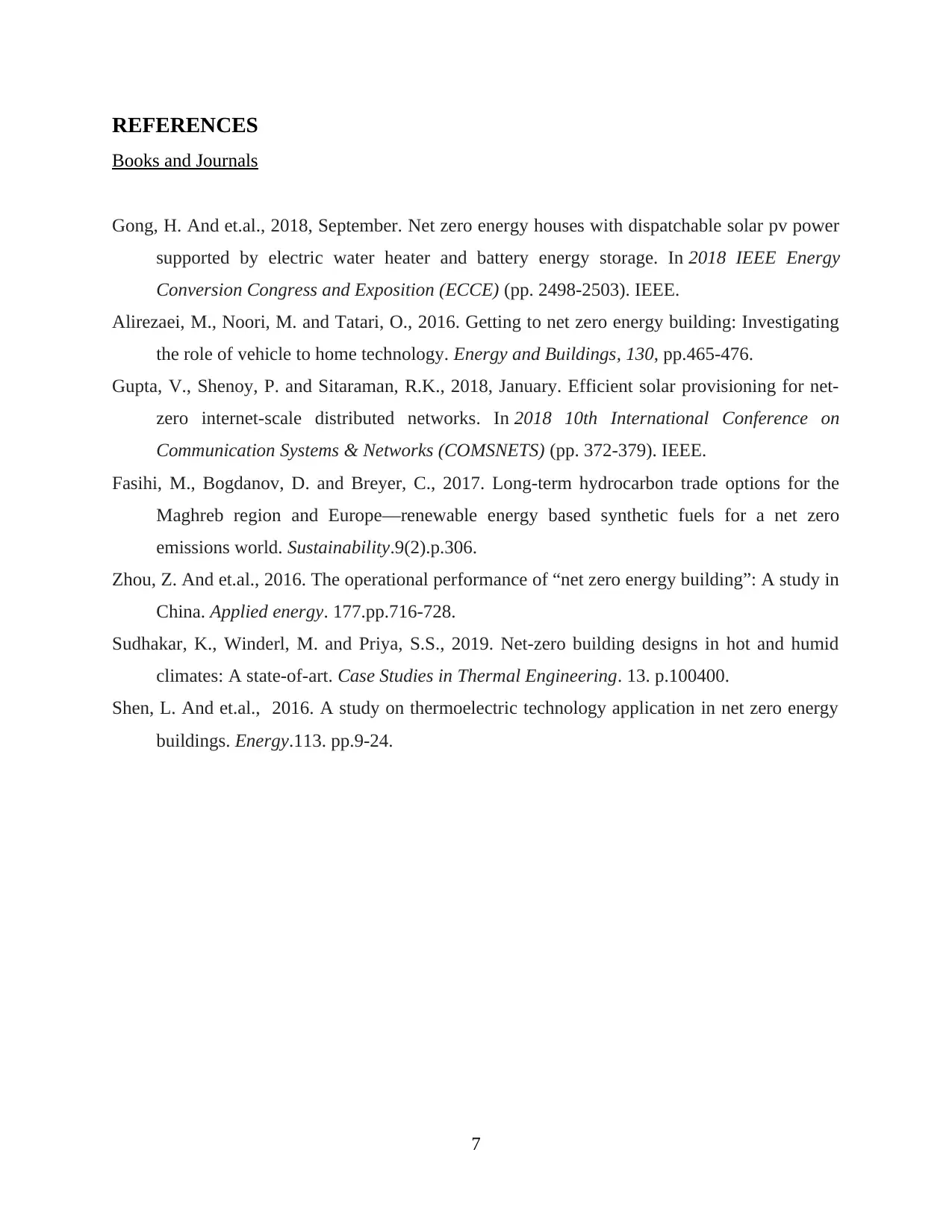
REFERENCES
Books and Journals
Gong, H. And et.al., 2018, September. Net zero energy houses with dispatchable solar pv power
supported by electric water heater and battery energy storage. In 2018 IEEE Energy
Conversion Congress and Exposition (ECCE) (pp. 2498-2503). IEEE.
Alirezaei, M., Noori, M. and Tatari, O., 2016. Getting to net zero energy building: Investigating
the role of vehicle to home technology. Energy and Buildings, 130, pp.465-476.
Gupta, V., Shenoy, P. and Sitaraman, R.K., 2018, January. Efficient solar provisioning for net-
zero internet-scale distributed networks. In 2018 10th International Conference on
Communication Systems & Networks (COMSNETS) (pp. 372-379). IEEE.
Fasihi, M., Bogdanov, D. and Breyer, C., 2017. Long-term hydrocarbon trade options for the
Maghreb region and Europe—renewable energy based synthetic fuels for a net zero
emissions world. Sustainability.9(2).p.306.
Zhou, Z. And et.al., 2016. The operational performance of “net zero energy building”: A study in
China. Applied energy. 177.pp.716-728.
Sudhakar, K., Winderl, M. and Priya, S.S., 2019. Net-zero building designs in hot and humid
climates: A state-of-art. Case Studies in Thermal Engineering. 13. p.100400.
Shen, L. And et.al., 2016. A study on thermoelectric technology application in net zero energy
buildings. Energy.113. pp.9-24.
7
Books and Journals
Gong, H. And et.al., 2018, September. Net zero energy houses with dispatchable solar pv power
supported by electric water heater and battery energy storage. In 2018 IEEE Energy
Conversion Congress and Exposition (ECCE) (pp. 2498-2503). IEEE.
Alirezaei, M., Noori, M. and Tatari, O., 2016. Getting to net zero energy building: Investigating
the role of vehicle to home technology. Energy and Buildings, 130, pp.465-476.
Gupta, V., Shenoy, P. and Sitaraman, R.K., 2018, January. Efficient solar provisioning for net-
zero internet-scale distributed networks. In 2018 10th International Conference on
Communication Systems & Networks (COMSNETS) (pp. 372-379). IEEE.
Fasihi, M., Bogdanov, D. and Breyer, C., 2017. Long-term hydrocarbon trade options for the
Maghreb region and Europe—renewable energy based synthetic fuels for a net zero
emissions world. Sustainability.9(2).p.306.
Zhou, Z. And et.al., 2016. The operational performance of “net zero energy building”: A study in
China. Applied energy. 177.pp.716-728.
Sudhakar, K., Winderl, M. and Priya, S.S., 2019. Net-zero building designs in hot and humid
climates: A state-of-art. Case Studies in Thermal Engineering. 13. p.100400.
Shen, L. And et.al., 2016. A study on thermoelectric technology application in net zero energy
buildings. Energy.113. pp.9-24.
7
⊘ This is a preview!⊘
Do you want full access?
Subscribe today to unlock all pages.

Trusted by 1+ million students worldwide
1 out of 9
Related Documents
Your All-in-One AI-Powered Toolkit for Academic Success.
+13062052269
info@desklib.com
Available 24*7 on WhatsApp / Email
![[object Object]](/_next/static/media/star-bottom.7253800d.svg)
Unlock your academic potential
© 2024 | Zucol Services PVT LTD | All rights reserved.





